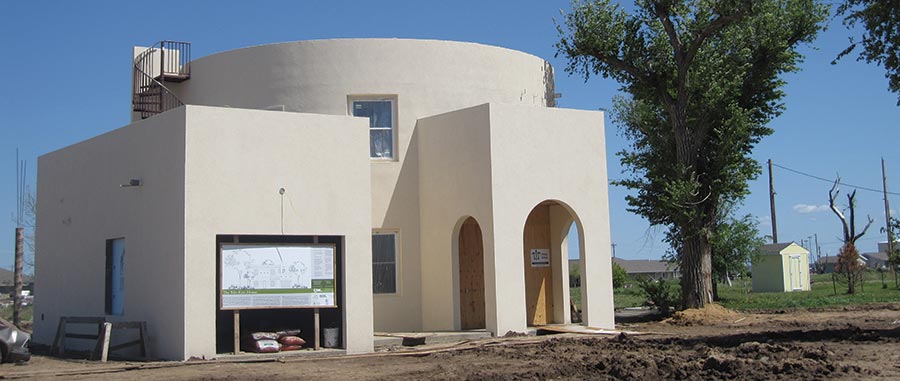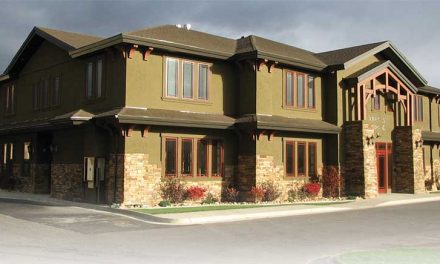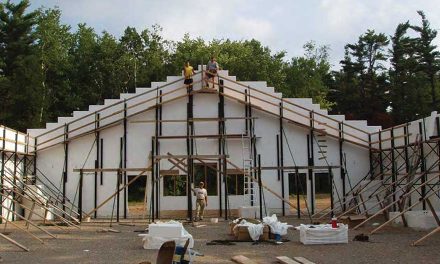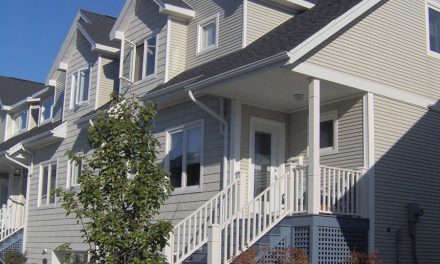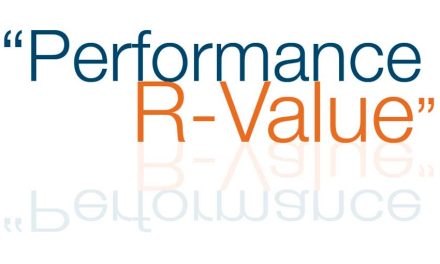How ICFs are Helping Rebuild America’s Most Famous Green Town
Two years ago, Greensburg, Kansas, was literally wiped off the map by one of the most powerful tornados in U.S. history. The F5 twister, with winds in excess of 200 mph, caused brick homes to collapse and frame houses to explode. Automobiles became missiles, hurled more than 100 yards away. More than 95% of the town was completely destroyed, with the remaining 5% being heavily damaged.
With a population of only 1,700, reporters openly speculated that the town was finished. But within a few days, town residents met and decided to rebuild; they would turn Greensburg into a model green community.
Curtis Nickel, a regional manager for Logix ICF, was at the first town hall meeting. “Greensburg is a low-income farming community,” he explains. “It may not be a wealthy, sophisticated town, but energy savings and disaster resistance were important enough to its citizens that they were willing to incur extra up-front costs to build what is arguably one of the most eco-friendly areas in the United States.
Kim Alderfer, assistant city manager for Greensburg, adds, “I would never say the tornado happening was a good thing. I would never wish that on anybody. But given the opportunity, we have to do it right — to make it better.”
ICFs are understandably a major part of the rebuilding effort. “You don’t experience a storm like this and come out of it with an attitude of complacency,” said Daniel Wallach, executive director of Greensburg GreenTown.
Wallach deserves much of the credit for the decision to build green. Immediately after the tornado, he stepped in and set up GreenTown as a nonprofit group to provide townspeople with technical assistance, classes, and other help to rebuild in an environmentally friendly way. He also set some lofty goals, encouraging every construction project in town to try for LEED Platinum certification. The town has committed that all public buildings will meet this stringent standard. To encourage corporate donations, Wallach has worked tirelessly with the media. Discovery TV has built an entire TV series around the rebuilding effort.
Why ICF?
With sustainability and disaster resistance as two top priorities, ICFs have understandably become a popular building material. “If you live in Greensburg, and you haven’t heard of ICFs, you’ve probably been living in your storm cellar the last few years,” Nickel jokes.
At least eight ICF manufacturers have a presence in the town, donating materials and labor to the building effort. Many have also exhibited at the local home shows, or have been awarded competitive bid projects.
“ICFs are a great choice for rebuilding,” says Nickel. “The temperature here fluctuates between 105 degrees in the summer and zero in the winter. An ICF wall has an R-value that’s consistent, and will be there forever. The concrete cures to 125% of design strength. It can take a 250 mph wind. If another storm comes through, that storm may affect the windows, but the basic structure is still there and it wouldn’t take a lot to rebuild.”
Patti Flesher, at the Portland Cement Association (PCA),
says concrete also contributes 19 to 28 LEED credits. Locally produced ICFs, like the Logix plant only 20 miles away from Greensburg, allow projects to achieve two additional points for using nearby materials.

Nearly twenty ICF homes have already been built in Greensburg. The first was this home, finished with half-log siding.
Success Stories
Ryan McDonald, an ICF contractor from Greensburg, has helped rebuild the town’s commercial core with disaster-proof ICFs. So far, the list includes three churches, the city hall, a grocery store, a People’s State Bank and at least two office buildings.
One of the ICF offices serves as a “business incubator.” The city subsidizes the rent of fledgling businesses until they can move out on their own. Current tenants include a law firm, an architect, and a clothes boutique.
Nickel reports that the Methodist Church is already expanding, adding an ICF sanctuary to the structure.
Quite a few of the homes are also being built with ICFs. “We’ve seen a good amount of interest, and good amount of activity,” reports Patrick McMahon, vice-president of sales and marketing at Amvic. “Per capita, there’s a high percentage of ICF homes. They’ve made a real effort to incorporate ICFs into their plans.
Many residents choose to build an ICF basement, and set a manufactured home on top. Above-grade ICF homes are also common. Nickel states that at least 15 new homes (including the mayor’s) have been rebuilt with ICFs. The new homes are energy-efficient, quiet, and built to survive whatever nature decides to unleash on Kansas in the years to come.
Farrell Allison is representative of these homeowners. Unlike many of his neighbors, he and his wife still have their jobs so they decided to rebuild. Allison says he’s always hated paying utility bills, and decided insulated concrete forms were the best concrete construction method available. Their new 2000 sq. ft. home has geothermal heat, energy-efficient windows, and a high-efficiency energy recovery system. “I’m not in this just for myself,” he says. “This house is for future generations who will live in it too.”
Publicity
Greensburg was in the public eye almost immediately after the tornado hit. As the site of the strongest tornado in almost 10 years, it was covered extensively by the national media, and received a personal visit from then-president George W. Bush. The decision to rebuild “green” has kept the town in the spotlight.
The CBS morning show covered the one- and two-year anniversaries of the tragedy, and President Bush returned in 2008 to deliver the high school commencement address.
Actor Leonardo DiCaprio took a personal interest in recovery efforts, and produced a series on the rebuilding efforts titled “Greensburg.” The documentary aired on Planet Green, a sister network of Discovery Channel. The first season consisted of 10 one-hour episodes. The second season is currently underway; six episodes have been shown so far.
“That documentary has reached across the United States,” says Nickel. “The extent to which it will influence the ICF industry is unknown. I do know that early on, they did a segment on the church, and that led directly to a job in Chicago.”
Many companies are donating product to the rebuilding effort, hoping that the publicity will help them as well.
BuildBlock has sent a large shipment of ICFs to FEMA (the U.S. Federal Emergency Management Agency), and Dryvit
donated the exterior finish for the new Silo Eco-Home, a 1,200 square-foot demonstration home. The Mohave-E finish is 40% lighter than traditional finishes and uses recycled glass
as aggregate.
Green vs. Sustainable
One issue that has repeatedly surfaced in the effort to build a green town is how much emphasis ought to be given to durability.
McMahon, at Amvic says, “We see a common link between a sustainable structure and the green initiative. We’re trying to ensure that when people hear green, they think sustainable structure.”
Often, however, durability is overlooked in favor of features like solar panels, wind turbines, tinted windows, and water-saving toilets. For example, GreenTown recently completed a series of 12 “eco-homes” that visitors can rent during their stay. The ICF example is slab-on-grade, with no basement or storm shelter, and features walls of windows—not an ideal home to find shelter in during a tornado. Other homes in the series are SIP, and wood frame.
Nevertheless, rebuilding efforts are beginning to emphasize durability. GreenTown has partnered with the American Institute of Architects (AIA) to sponsor a design contest.
“We welcome designs of all sizes, as long as they cost less than $110 per square foot,” read the contest rules. “That means that a 1,400 sq. ft. home would cost $154,000.” Entrants can choose between three exterior wall systems, the winning plan in each category will be built. One of the three is ICF. (The other two are “Environmental Masonry Units,” similar to concrete block but using lime instead of Portland cement, and “Pre-fab Wood Blocks,” made of woodchips soaked in clay and mussel shells.)
Winners will be announced in mid-October. All ICF entries must use Amvic Block.
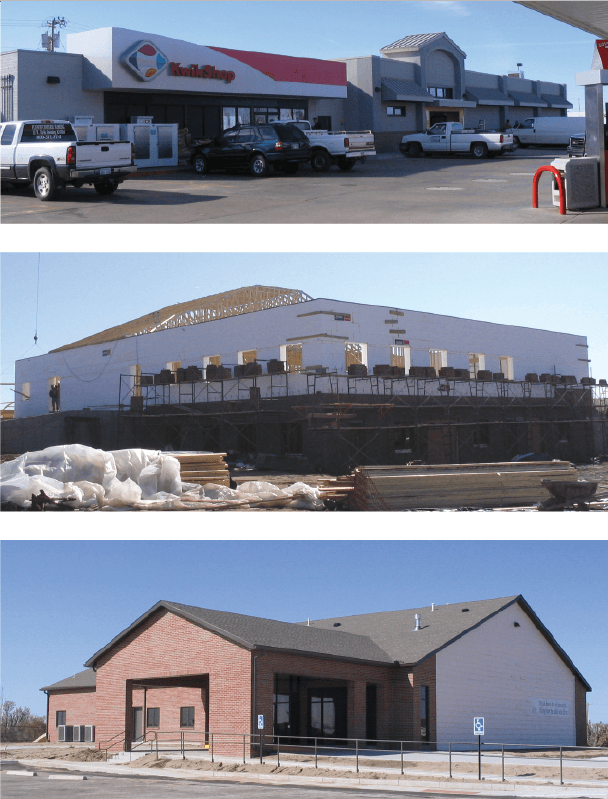
Commercial ICF buildings in town include the city hall, a bank, a grocery store/filling station (top), at least two office buildings, and three churches. The Methodist church (middle and bottom) is already expanding with an ICF sanctuary addition.
Challenges
As noted earlier, Greensburg is not a particularly affluent town. That’s why the home plan competition is designed to encourage small, affordable house plans. It’s also a hurdle for the ICF industry.
“The citizen response to our product has been very good,” says Nickel. “It comes down to finances. A lot of the town was underinsured. Because the policies were not kept up-to-date, insurance payouts may only cover 40 to 50% of the replacement cost.”
The lack of jobs is also keeping people away. About half the town’s residents have yet to come back. Some cannot afford to rebuild, while others have moved on to other opportunities and settled elsewhere.
Chance of a Lifetime
Still, the town has already become a national landmark for green building. More than 20 buildings have already been LEED-certified. Says Wallach, “This is truly a once-in-a-lifetime opportunity to show the world how we can build green.”
Erica Goodman, a city councilwoman, says that the end result will be “a stronger, better, greener community.”
“I think the green initiative is really what will set Greensburg apart from every other rural community in the United States.”

